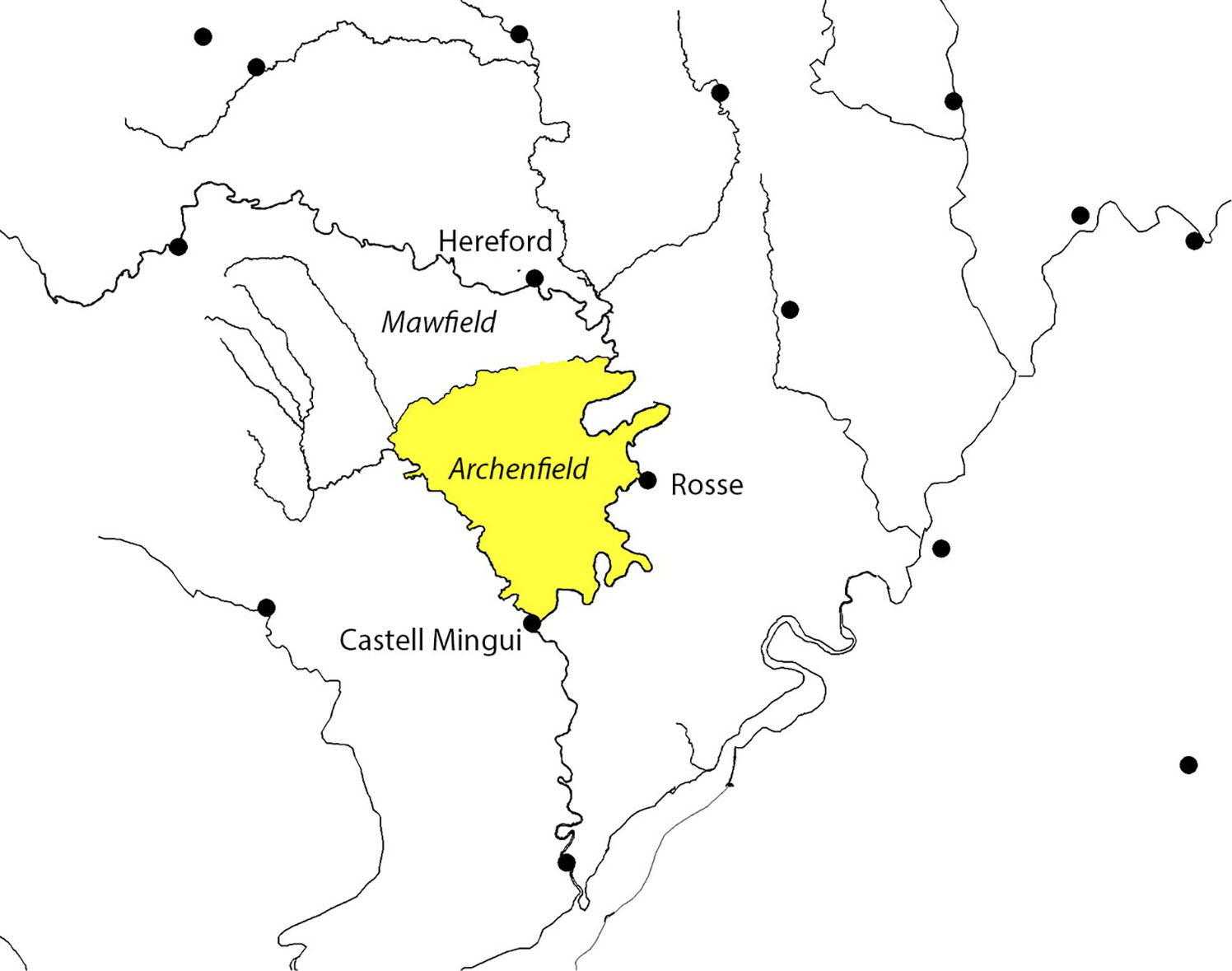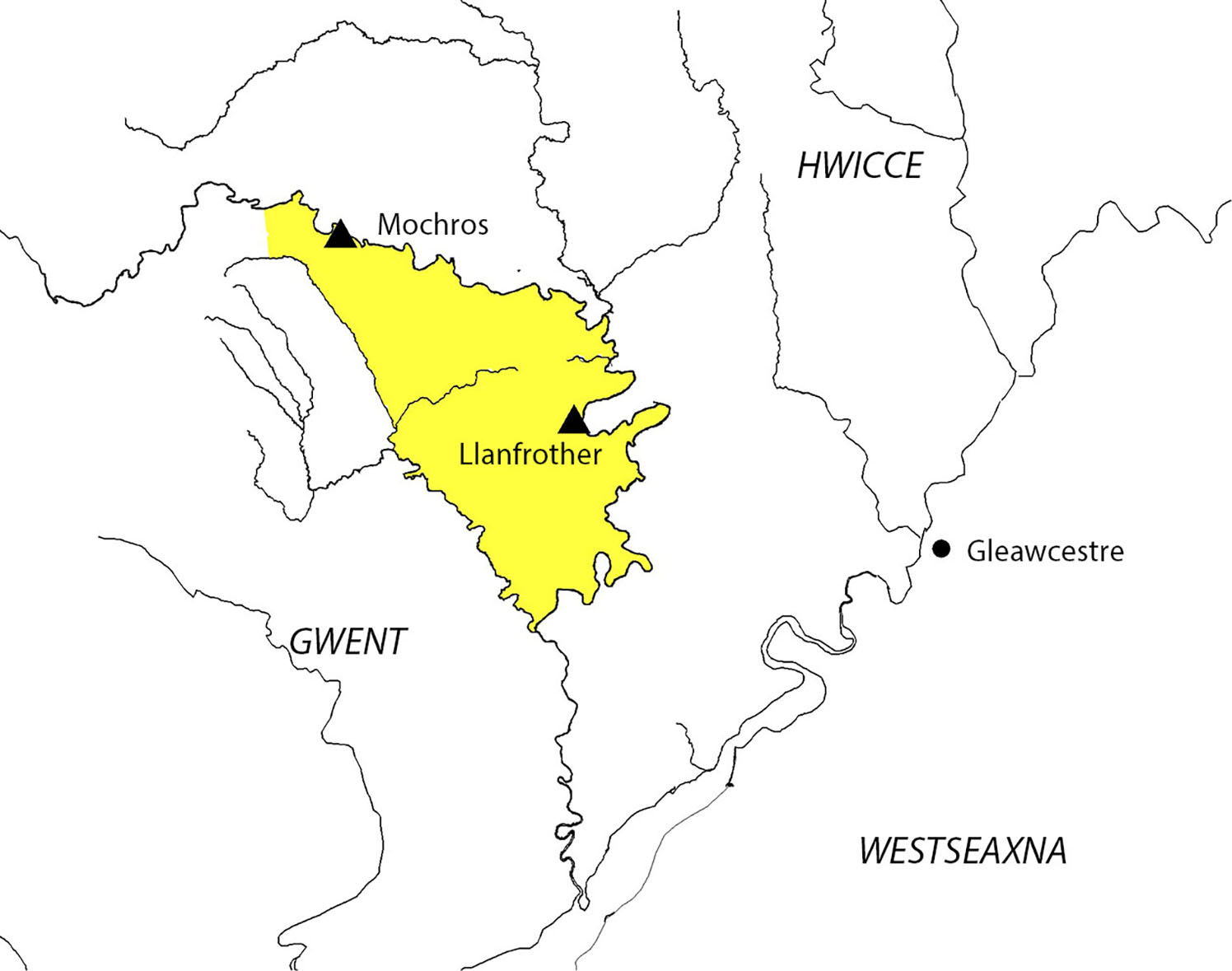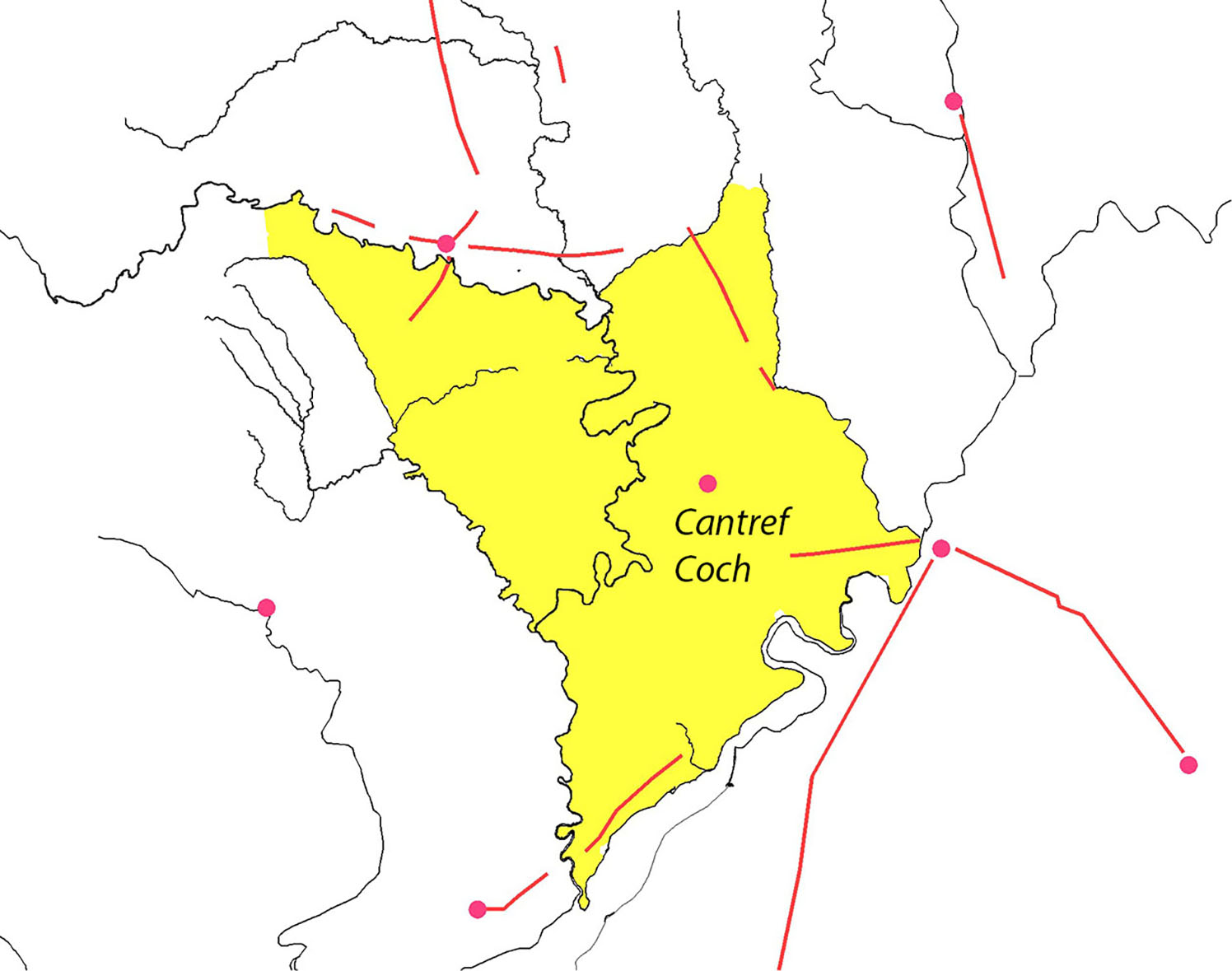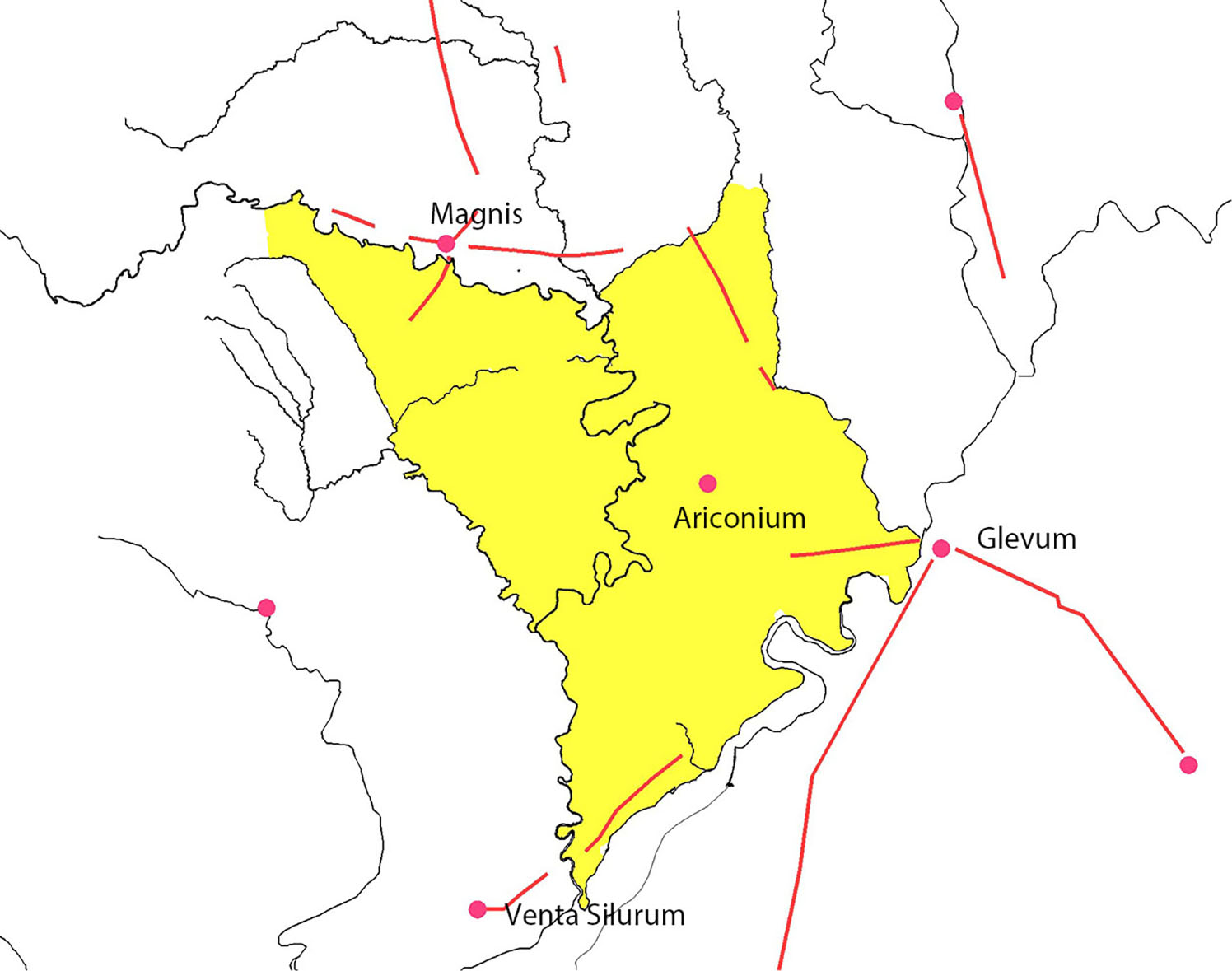the decline of Ergyng
Erging was one of a number of small political entities which replaced the centralised structure after the withdrawal of the Roman legions from Britain in 410 AD. The kingdom of Ergyng (or Ercic) seems to have been based on, and named after, the old Romano-British industrial town of Ariconium and covered what is now southern Herefordshire.
To the west of Ergyng, the town of Venta [Silurum] (Caerwent) gave its name to the kingdom of Gwent. Historically and culturally both Gwent and Ergyng must be considered as firmly belonging within South East Wales. Beyond Gwent, Glywysing occupied modern Glamorganshire.
Caradog Freichfras
Much of the story of Kings of Ergyng should be considered legendary rather than historical, and the royalty of south East Wales in this period need some unpicking. King Caradog Freichfras(strong arm) was born in about 470, and he has threads connecting in several directions and to several tales. He was king of Gwent and Broerec. This is an early link between South East Wales and Brittany (then Armorica). Broerec is Bro Gwened the area around Vannes in Brittany, where the Christian Britons were taking refuge from the invading pagan Anglo-Saxons; ultimately giving the area the name Bretagne. The Breton name for Vannes is Gwened. In Breton legend Caradoc held court at Nantes, but this may have become confused with Caerwent, which in some sources is Carnant (Caer-Nantes). On the whole, the Caerwent association seems more probable. In legend Caradoc Freichfras, Caradoc Vreichvras (in Old Welsh), is also associated with Caradoc Court in Selleck, the parish adjacent to Hentland. He is heavily woven into Arthurian legend.
Meurig ap Caradog
Meurig (Maurice in English) was the only son of Caradog Freichfras. By his marriage to Dyfwn, the only daughter of King Glywys of Glywysing, he united Gwent and Glywysing into one kingdom. Through his son Erbig he was the ancestor of several generation of South Welsh kings. Erbig's son Erb (Latin: Urbanus in Latin, Urban in English) died in about AD 575, when an older son, Nynnio, became King of Gwent and Glywysing; and a younger son, Peibio, took the smaller kingdom of Ergyng.
Peibio Clafrog
Peibo Clafrog (Clafrog originally meant 'the leprous' but later was taken to have meant 'the dribbler) was King of Ergyng, and died in about AD 585. He is believed to have married a daughter of King Constantine of Dumnonia. Gildas in his De Excidio et Conquestu Britanniae bitterly condemns five contemporary British kings, among whom Constantine is referred to as 'the tyrannical whelp of the unclean lioness of Damnonia'. Peibo had at least four sons (Cynfyn, Gwyddgi, Cynwst and Tewdr) and a daughter, Ebrdil, who, in a miraculous birth legend, gave birth to St Dyrig. An area adjacent to the Wye upstream of Hereford was called after her Ynys Ebrdil - the isle of Ebrdil. Cynfyn ap Peibio and Gwyddgi ap Peibio may have been joint rulers of Ergyng.
Cynfyn ap Peibio died in around AD 615, and the throne of Ergyng, which should have passed to his son Gwrgan, was seized by a usurper, Gwrfoddw. Gwrfoddw was King of Ergyng when he granted lands at Bellamore, upstream of Hereford, in Ynys Ebrdil, in about AD 610. This charter tells of a recent victory of Gwrfoddwm rex Ercycg over the Saxons. So at that time, although Ergyng was in conflict with Anglo-Saxons, it still held the right bank of the Wye above the site of Hereford (although at that time Hereford did not exist). In AD 615 he granted land at Garway.In the kingdom of Gwent and Glywysing,Tewdrig ap Teithfallt, grandson of Nynnio ap Erb of Ergyng, became king. Tewdrig abdicated in favour of his son, Meurig ap Tewdrig, and retired to be hermit.In about AD 630 the Anglo-Saxons were threatening Gwent and Tewdrig came out of retirement. Together Tewdrig and Meurig drove back the Anglo-Saxons, gaining a victory at the Battle of Pont Y Saeson - 'the Bridge of the Saxons', on the lower Wye. This was one of the most significant battles in British history. It permanently saved South Wales from the English.
In Ergyng, Cynfyn's son Gwrgan became king after Gwrfoddw, and the line was restored. Gwrgan Fawr (meaning Gwrgan the Great, although little is known about him) may have died in about 645. Gwrgan (in Latin, Gurgantius; English Fergus) should have been succeeded by his sons, Caradog and Morgan. But Gwrgan also had a daughter Onbraust who married King Meurig of Glywysing/Gwent, and the kingdom of Glywysing/Gwent passed to their son Athrwys.
This process, by which smaller kingdoms and territories became part of larger ones, reversing a presumed post-Roman fragmentation, must have taken place in all parts of Britain, although the records are flimsy.
Alliances were formed, often between Germanic and British kingdoms. Larger groupings would in themselves have encouraged smaller kingdoms to seek alliances with larger neighbours. Ultimately, even the larger kingdoms merged - by the early 9th century, Powys, weakened by its struggle with Mercia, was absorbed by Gwynedd.
Athrwys ap Meurig, King of Ergyng (c.AD 630-c.AD 655)
Athrwys seems to have become king of Ergyng. That would have been by right of his mother; her brothers, Caradog and Morgan being passed over. The hand of his powerful father is widely suspected to have played a part in this. His son Morgan ap Athrwys was king of Gwent and Glywysing (Morgannwg). He would have been heir to Ergyng through his grandmother Onbraus ferch Gwrgant Mawr (above).But Athrwys may not have been king of Gwent and Glywysing as he might have died before his father
Morgan ap Athrwys
Morgan was the grandson and probable successor of King Meurig. It has been argued that his timing, and the fact that he ruled over Gwent and Glywysing makes him the probable eponym for the later kingdon of Morgannwg (modern Glamorgan). His descendant Morgan Hen is another possibility. Through his grandmother Onbraus ferch Gwrgant Mawr, he may have been heir to the kingdom of Ergyng as well. Morgan's son Ithel ap Morgan divided the kingdom between his sons. Ffernfael got Gwent, and Rhys, Rhodri, and Meurig got parts of Glywysing.
Early in the 8th century King Æthelbald of Mercia (716-757) seems to have moved against the Welsh of the area
In 722AD forces of Gwent/Glywysing, presumably under Ithel ap Morgan, defeated the Mercians at a place called Pencon. However, the initiative passed to the Mercians by 743 when Cuthred of Wessex joined Æthelbald in war against the Welsh.
Ithel had regained control of at least the greater part of Ergyng in 745, and returned 11 churches there to Bishop Berthwyn of Ergyng. The grant returning these churches is recorded in the Book of Llandaff. It records the destruction of the border towards Hereford by the 'most treacherous Saxon race' saxonica gente infidelissima .
Although Erging lost its kings, it retained its identity. Recognisably separate groups of leading men of Ergyng, Gwent and Glywysing continued to be present, in their respective areas, at the granting of charters into the 8th or 9th centuries.
Mercia was a growing power and its greatest king, Offa probably fortified a settlement at Hereford in the mid 8th century in which he placed a bishop, who was subordinate to the Mercian mother church at Lichfield. Offa persuaded the Pope to create Lichfield as a third English archbishopric to join Canterbury and York. Hygeberht (died after 803) was the only Archbishop of Lichfield.
If Hereford became an English bishopric, any claim the bishops of Hereford made to the parishes which had been in Erging/Archenfield were bitterly disputed by the bishops of LLandaff, who saw themselves as the successors of Dyfrig.
The process by which Ergyng came to be dominated by the English-speaking Mercians remains obscure, but certainly happened in stages over a long period of time.
Erging was one of the several British bishoprics which ultimately formed the diocese of Llandaff.



